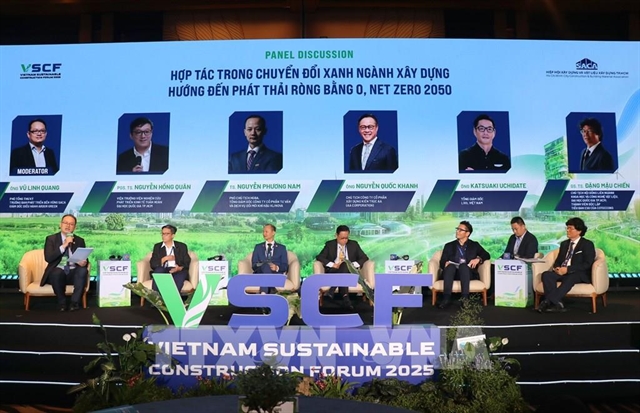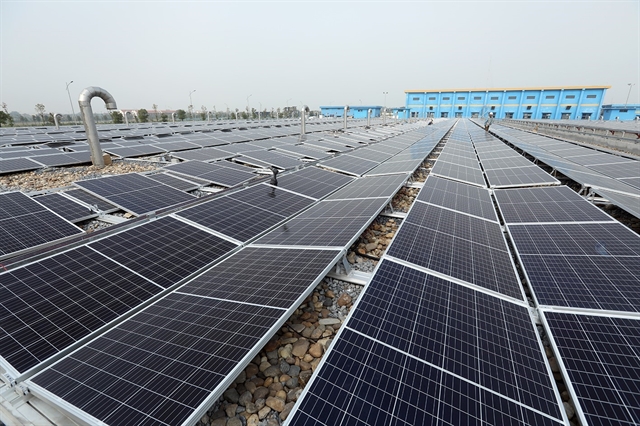 Economy
Economy


|
| A part of a solar panel project at Đuống River Surface Water Plant. VNA/VNS Photo |
HÀ NỘI — The outlook of coal-fired power and renewable energy groups in 2022 is positive, especially coal-fired power plants in the north as they may benefit from water shortages in the coming months.
In a recent report, Agriseco Research said that the output growth of the electricity industry in 2021 will slow down due to the impact of COVID-19 and the prolonged social distancing in many key economic regions.
The electricity output of the whole system in the first nine months of the year was estimated at 213 billion kWh, up 3.3 per cent over last year. However, in the third quarter, the output decreased by 7 per cent compared to the second quarter.
It is reasonable as normally the annual growth of electricity production in Việt Nam is about 1.5 - 2 times higher than GDP growth. Accordingly, with a GDP growth target of 6 - 6.5 per cent in 2022 and a low base of 2021, Agriseco Research expects the power industry to return to double-digit growth next year.
Favourable hydrological factors
The report showed that the prospect of coal-fired power and renewable energy groups in 2022 is positive. Of which, coal-fired power plants in the north may benefit from the water shortage in the coming months and the slower growth in power generation compared to the growth in load.
Besides, in the medium and long term, gas-fired power and renewable energy groups are expected to gradually replace traditional energy sources such as coal and hydroelectricity.
The draft of Power Plan VIII has opened up new opportunities for the electricity industry in general and power sources in particular. Of which, small hydroelectricity power plants with an additional capacity of about 6,000 MW will be in focus because larger-scale projects have almost reached their full capacity.
Coal-fired power and gas-fired power (gas turbine engine) plants will also play a key role until 2030 due to the advantage of easy selection of plant locations close to areas with high load demand, especially in the north.
Renewable energy segment
For the renewable energy segment, it is expected to replace traditional energy with the largest proportion in 2045. Thanks to the incentives on electricity generation prices, the solar power capacity has reached 16,500 MW, accounting for 25 per cent of the system capacity.
Meanwhile, wind power is at the beginning of the development period as its installed capacity still has 7,000 MW left by 2025, with the compounded annual growth rate (CAGR) of 30 per cent.
Therefore, in the 2022-23 period, Agriseco Research believes that wind power will still receive incentives to achieve the growth target.
Moreover, the net life cycle costs of renewable energy projects are also in a strong downtrend. Solar projects’ installation costs that account for the majority with over 50 per cent of the total cost of a renewable energy project fell by 7 per cent, while that of offshore wind projects dropped 9 per cent and onshore wind power projects decreased by 13 per cent.
The declines were driven by the application of technology and price competition among turbine and solar panel suppliers in the world, Agriseco said.
Hence, the cost of installing solar and onshore wind projects may be cheaper than coal-fired power in the next few years when the equipment market is gradually saturated. The trend will ensure profit margins for investors in new projects when the price mechanism gradually shifts from the fixed incentive to the bidding mechanism.
Potential gas-fired power segment
In the gas-fired power segment, factories are now taking advantage of cheap domestic gas fields, which are gradually running out. Agriseco Research believes that gas-fired power will play an important role in the power plan in the northern region, especially amid limited coal-fired power development.
Currently, liquefied natural gas (LNG) storage facilities are being built across the country, including in Quảng Ninh, Hải Phòng and Thanh Hóa areas.
However, the report noted that unlike renewable energy projects, a gas-fired power project usually has a large capacity and requires huge investment capital.
Therefore, gas-fired power projects often need more time to look for investors and capital arrangement, especially projects without government guarantees.
Agriseco believes that this will be a big barrier for gas-fired power projects to complete the operation schedule, and get consensus on the electricity price in the power purchases agreement (PPA) with Việt Nam Electricity (EVN).
Agriseco Research also said that utilities stock prices, in general, are quite attractive compared to the market valuation, with healthy financial situation and regular dividends. So they are suitable for long-term holding, the company added. VNS